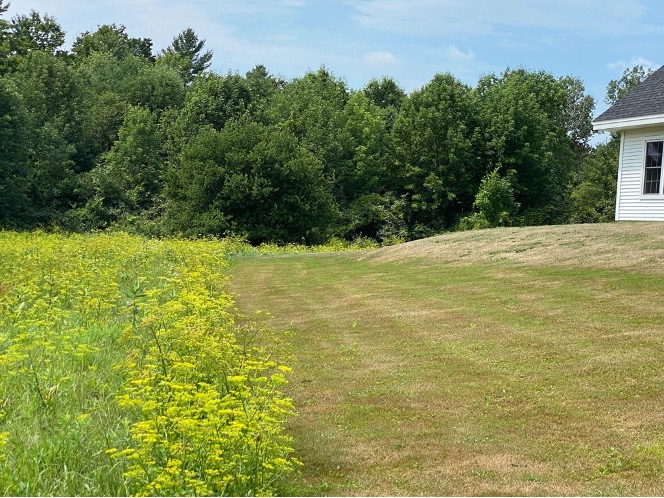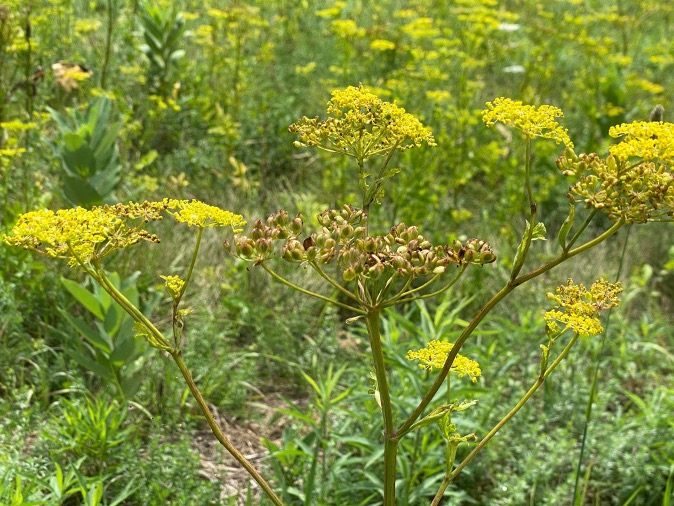Bulletin #2585, Wild Parsnip: A Problem Plant in Need of Management in Maine
By Brett Johnson, Assistant Extension Professor, Sustainable Agriculture and Farm Business Management Educator, University of Maine Cooperative Extension
For information about UMaine Extension programs and resources, visit extension.umaine.edu.
Find more of our publications and books at extension.umaine.edu/publications/.
Why is This Plant an Issue?
Wild parsnip causes phytophotodermatitis through skin contact with sap containing photosensitizing phytochemicals called furanocoumarins. These chemicals increase our skin’s sensitivity to ultraviolet (UV) radiation from the sun. When the skin absorbs psoralen and is then exposed to sunlight the result is often severe blistering of the skin. Wild parsnip presents health hazards for all who come in contact with its sap but especially those who commonly work or recreate in areas where large populations of parsnip are located, such as road crews, lineworkers, land managers, farmers, farmworkers, or hikers.
Biology and Ecology of Wild Parsnip
Wild parsnip (Pastinaca sativa L.) is a monocarpic perennial, a member of the carrot family (umbellifers), native to Europe and Asia and introduced to North America as a cultivated root vegetable. This plant grows to between 3 and 5 feet tall in the second year of development. In the first year, the plant forms a basal rosette of pinnately compound leaves. The plant overwinters quite successfully in Maine and, during the second or subsequent growing seasons, bolts by sending up a flower stalk with a deeply grooved stem, topped with umbel-shaped yellow inflorescences. Wild parsnip reproduces via seed that is borne within flat, dry, winged fruit. Reproductive capacity is high, with one plant capable of producing 1,000 seeds.
Seed is dispersed primarily by wind and, to a lesser degree, by surface water. In managed landscapes, seed is often moved by mowing equipment, boots, tools, or tillage implements. Transporting contaminated hay or straw introduces wild parsnip into previously unaffected areas and contributes to populations increasing along roadsides. Wild parsnip requires part to full sun conditions. This plant becomes established in disturbed areas that are infrequently managed, such as roadsides or field edges that are not routinely mowed (see Figure 1).

Management
When working in or around wild parsnips, wear a light-colored, loose-fitting, long-sleeve shirt, pants, gloves, safety glasses, and face and neck coverings to prevent direct contact with plant sap. If sap contacts skin, wash skin with soap and water immediately, and keep skin out of the sun to prevent a reaction. In small, localized populations the most effective management is through digging. Severing the stem from the root by digging 1–2 inches below the soil line with a shovel will kill parsnip when the plant is in flower. For small plant populations in the first season of growth, spot treatment with herbicides labeled for wild parsnip can achieve control.
In situations where endemic landscape-level populations are established, mowing may be the only economic management strategy. Managers must commit to mowing multiple times throughout the year for several subsequent years to achieve long-term control. Effective mowing efforts should target the flowering stage in the life cycle of wild parsnip and should occur when plants are in flower but before seed matures (see Figure 2).

Always follow label directions when applying herbicides. For more information and for specific recommendations, contact the University of Maine Cooperative Extension at 207.581.3188 or by email at extension@maine.edu.
Information in this publication is provided purely for educational purposes. No responsibility is assumed for any problems associated with the use of products or services mentioned. No endorsement of products or companies is intended, nor is criticism of unnamed products or companies implied.
© 2024
Call 800.287.0274 (in Maine), or 207.581.3188, for information on publications and program offerings from University of Maine Cooperative Extension, or visit extension.umaine.edu.
In complying with the letter and spirit of applicable laws and pursuing its own goals of diversity, the University of Maine System does not discriminate on the grounds of race, color, religion, sex, sexual orientation, transgender status, gender, gender identity or expression, ethnicity, national origin, citizenship status, familial status, ancestry, age, disability physical or mental, genetic information, or veterans or military status in employment, education, and all other programs and activities. The University provides reasonable accommodations to qualified individuals with disabilities upon request. The following person has been designated to handle inquiries regarding non-discrimination policies: Director of Equal Opportunity and Title IX Services, 5713 Chadbourne Hall, Room 412, University of Maine, Orono, ME 04469-5713, 207.581.1226, TTY 711 (Maine Relay System).

